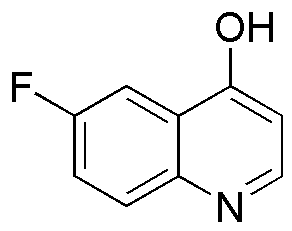6-Fluoro-4-hydroxyquinoline is widely utilized in research focused on:
- Pharmaceutical Development: This compound serves as a key intermediate in the synthesis of various pharmaceuticals, particularly in developing anti-infective agents and anti-cancer drugs.
- Antimicrobial Applications: Its unique structure allows it to exhibit antimicrobial properties, making it valuable in formulating treatments for bacterial infections.
- Fluorescent Probes: The compound can be used to create fluorescent probes for biological imaging, aiding researchers in studying cellular processes and disease mechanisms.
- Analytical Chemistry: It is employed in analytical methods for detecting and quantifying other compounds, enhancing the accuracy of chemical analyses in laboratories.
- Material Science: The compound's properties make it suitable for developing advanced materials, including coatings and polymers that require specific chemical resistance.
General Information
Properties
Safety and Regulations
Applications
6-Fluoro-4-hydroxyquinoline is widely utilized in research focused on:
- Pharmaceutical Development: This compound serves as a key intermediate in the synthesis of various pharmaceuticals, particularly in developing anti-infective agents and anti-cancer drugs.
- Antimicrobial Applications: Its unique structure allows it to exhibit antimicrobial properties, making it valuable in formulating treatments for bacterial infections.
- Fluorescent Probes: The compound can be used to create fluorescent probes for biological imaging, aiding researchers in studying cellular processes and disease mechanisms.
- Analytical Chemistry: It is employed in analytical methods for detecting and quantifying other compounds, enhancing the accuracy of chemical analyses in laboratories.
- Material Science: The compound's properties make it suitable for developing advanced materials, including coatings and polymers that require specific chemical resistance.
Documents
Safety Data Sheets (SDS)
The SDS provides comprehensive safety information on handling, storage, and disposal of the product.
Product Specification (PS)
The PS provides a comprehensive breakdown of the product’s properties, including chemical composition, physical state, purity, and storage requirements. It also details acceptable quality ranges and the product's intended applications.
Certificates of Analysis (COA)
Search for Certificates of Analysis (COA) by entering the products Lot Number. Lot and Batch Numbers can be found on a product’s label following the words ‘Lot’ or ‘Batch’.
*Catalog Number
*Lot Number
Certificates Of Origin (COO)
This COO confirms the country where the product was manufactured, and also details the materials and components used in it and whether it is derived from natural, synthetic, or other specific sources. This certificate may be required for customs, trade, and regulatory compliance.
*Catalog Number
*Lot Number
Safety Data Sheets (SDS)
The SDS provides comprehensive safety information on handling, storage, and disposal of the product.
DownloadProduct Specification (PS)
The PS provides a comprehensive breakdown of the product’s properties, including chemical composition, physical state, purity, and storage requirements. It also details acceptable quality ranges and the product's intended applications.
DownloadCertificates of Analysis (COA)
Search for Certificates of Analysis (COA) by entering the products Lot Number. Lot and Batch Numbers can be found on a product’s label following the words ‘Lot’ or ‘Batch’.
*Catalog Number
*Lot Number
Certificates Of Origin (COO)
This COO confirms the country where the product was manufactured, and also details the materials and components used in it and whether it is derived from natural, synthetic, or other specific sources. This certificate may be required for customs, trade, and regulatory compliance.


